
Falling Dart Impact Testing Machine
Product Details:
- Interface Type Manual operation
- Temperature 10C 40C
- Resolution 1 g
- Frequency 50 Hz
- Measuring Range 0 2,000 g
- Specimen Size Up to 160 mm width, sheet/film samples
- Number of Specimens 1 per test
- Click to view more
Falling Dart Impact Testing Machine Price And Quantity
- 1 Set
- 1399.00 - 2999.00 USD ($)
Falling Dart Impact Testing Machine Product Specifications
- Up to 160 mm width, sheet/film samples
- Max. 1,000 mm
- 1 per test
- Digital/Analog, depending on model
- 0 2,000 g dart
- 230V AC, 50 Hz
- 0 2,000 g
- Manual operation
- 50 Hz
- Laboratory and industrial testing
- 10C 40C
- Up to 160 mm
- 1 g
- 0 2,000 g
- Approx. 70 kg
- Impact resistance testing of plastic films and sheets
- Manual release mechanism
- Height adjustable; Rugged steel frame; Powder coated finish; Safety enclosure; Adjustable clamp for specimen
- Instantaneous on impact
- 1,000 mm
- Falling Dart Impact Testing Machine
- Manual
- Floor standing
- Up to 85% RH, non-condensing
- 230V AC
- 1 g
- Standard free-fall (gravity) 2.5 0.2 m/s
Falling Dart Impact Testing Machine Trade Information
- shenzhen
- 300 Set Per Month
- 7 Days
- All India
Product Description
Falling Dart Impact Testing Machine
Application:
It is used to measure the impact mass and energy of 50% plastic film or sheet when the plastic film or sheet with a thickness of less than 1mm is impacted by a free falling dart at a given height.
Features:
- 2 test methods of A & B and automatic determination of testing status
- Electromagnetic suspension and automatic release of the falling dart reduce the errors caused by manual operation
- Pneumatic clamping, 2 starting modes of manual and pedal switch and built-in observation light are convenient to the users operation
- Professional software supports multi-unit result display, graphic display of testing process and data export and printing
- Equipped with USB port and micro printer port which is convenient for data transmission and PC connection
Principle:
Before starting the test, choose test method, and estimate an initial mass and m. Start the test. If the first specimen fails, decrease the mass of the falling dart by m. If the first specimen is not a failure, increase the mass of the falling dart by m. Continue the test according to this rule. In brief, increase or decrease by m according to whether the former specimen is a failure or not. After 20 specimens, calculate the total number of failed specimens N. If N equals to 10, the test is over. If N is less than 10, add specimens and continue to test until N equals to 10. If N is greater than 10, add specimen and continue the test until the number of non-failure specimens reaches 10. Then the tester calculates the test results automatically according to specific formulas.
Standards:
This instrument conforms to various national and international standards:
ASTM D1709, ISO 7765-1-1988, JIS K7124-1, GB/T 9639.1-2008
Technical Specifications:
Specifications: DH-BMC
Test Method: Method A or Method B is optional
Test Range: Method A: 50-2000 g
Method B: 300-2000 g
Accuracy: 0.1 g (0.1J)
Specimen Clamp: Pneumatic Clamp
Pressure of Gas Supply: 0.6 MPa (outside of supply scope)
Power Supply: AC 220V 50Hz
Net Weight: 70 kg
Instrument Dimension:
Method A: 500 mm (L) *450 mm (W) * 1320 mm (H)
Method B: 500 mm (L) * 450 mm (W) * 2160 mm (H)
Versatile and Adjustable Design
Tailored for a wide range of testing requirements, this impact tester offers an adjustable drop height from 300 mm to 1,000 mm and supports various dart diameters. The pneumatic or manual clamping system secures specimens for consistent results. Its durable construction and powder-coated finish make it reliable for frequent laboratory or industrial use.
Enhanced Safety and Ease of Use
Safety is paramount, thanks to features including a protective screen and emergency release lever. Single-operator use with manual operation simplifies procedures without compromising security or accuracy. The intuitive design allows quick setup and test execution, making it accessible for operators at all skill levels.
FAQs of Falling Dart Impact Testing Machine:
Q: How does the Falling Dart Impact Testing Machine operate during an impact test?
A: The machine functions by manually releasing a stainless steel or cemented carbide dart from an adjustable height (300 mm to 1,000 mm) onto a clamped specimen. The impact force, measured instantly, is displayed digitally or analogically, helping to evaluate the materials resistance to impact.Q: What types of specimens and dart weights can this machine accommodate?
A: It is designed for testing plastic films and sheets up to 160 mm in width, using darts ranging from 0 to 2,000 grams. Dart diameters of 38 mm and 50 mm are standard, with custom options available to suit specific testing needs.Q: Where is the Falling Dart Impact Testing Machine typically used?
A: This machine is widely used in laboratory and industrial settings for quality control and product development by manufacturers, exporters, and suppliers of plastic films and sheets, ensuring material durability and compliance with standards.Q: What process should be followed to ensure safe and reliable testing?
A: Operators should securely clamp the sample using the pneumatic or manual mechanism, select the desired drop height, and ensure all safety featuressuch as the protective screenare in place. Testing is done by manually releasing the dart and recording the impact measurement.Q: When should calibration or maintenance be performed?
A: Regular checks should be conducted before use and after significant testing batches. Clean the platform, check clamps, inspect the release mechanism, and verify measurement accuracy periodically to maintain consistent results.Q: What are the key benefits of using this impact tester?
A: The system delivers accurate, repeatable results for impact resistance, supports multiple specimen and dart configurations, and features robust safety elements. It is also built for longevity, with corrosion-resistant materials and solid construction ensuring dependable operation over time.
Price:
- 50
- 100
- 200
- 250
- 500
- 1000+








